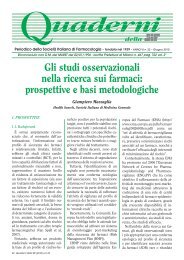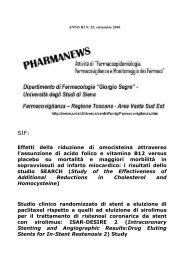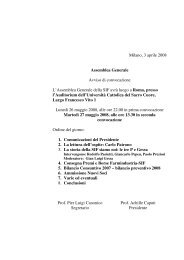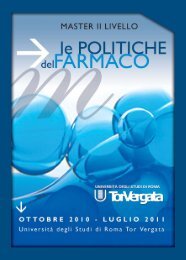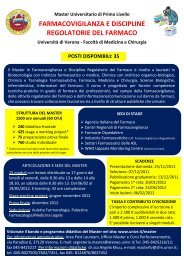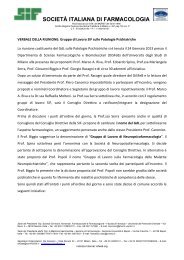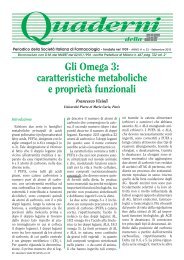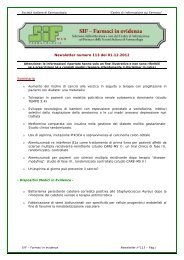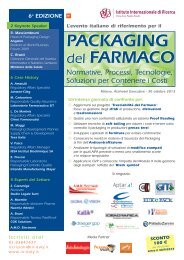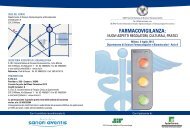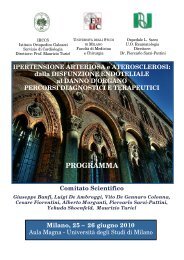scienze della vita roma, 22-23 ottobre 2012 - SIF
scienze della vita roma, 22-23 ottobre 2012 - SIF
scienze della vita roma, 22-23 ottobre 2012 - SIF
Create successful ePaper yourself
Turn your PDF publications into a flip-book with our unique Google optimized e-Paper software.
KHCO3 AND D-RIBOSE: IN VITRO SLOWDOWN<br />
OF CANCER CELL GROWTH<br />
S.Croci 1,2 , L. Bruni 1,2,3<br />
1 Neuroscience Department, Biophysics and Medical Physic Unit, Parma University<br />
2 INBB- Nation Institute of Biosystem and Biostructure - Rome<br />
3 Valsè Pantellini Foundation, Oviedo, Asturia Spain<br />
Cancer cells have a glycolysis enhancement even in the presence of available oxygen. The “aerobic<br />
glycolysis”, known as the Warburg effect, is considered a fundamental metabolic alteration during<br />
malignant transformation. The up-regulation of glycolysis in tumour cells is well known and it is<br />
the rationale of F 18 -FDG PET diagnostic technique. This propriety is strictly link to the increase of<br />
sugar transporters (GLUTs) in most tumours. Also SGLT family transporters, which include the<br />
sodium-glucose symporter, are deregulated in many tumours. The influx of Na + into tumour cells<br />
leads to a change into ions equilibrium, with particular reference to K + intracellular concentration.<br />
We investigated the effect of K:D-Rib on cell proliferation. Experiments performed on HTB-126<br />
cells (human breast adenocarcinoma) demonstrate that the synergic action of KHCO3 and D-ribose<br />
(K:D-Rib) has a cytostatic effect, reducing by 30% the doubling population time of treated cancer<br />
cells respect to the control.<br />
HTB-126 cells were sown to perform the clonogenic assay. The water solution tested were K:D-Rib<br />
and K:D-Frutt (KHCO3 and D-fructose) at the concentration of 5mM. The clonogenic assay shows<br />
that the colonies formed during the incubation with 5 mM K:D-Rib (10 colonies) are significantly<br />
less respect to the control (<strong>23</strong> colonies) but not if D-fructose (12 colonies) is used instead D-ribose.<br />
The colony shape of cells treated with K:D-Rib and K:D-Frutt appears confined and with the inner<br />
part more compact respect to the control.<br />
These experimental evidences drive us to consider a fine-tuning of K + concentration regulation. The<br />
concentration of K + is measured by the folding of DNAzyme. This molecule has the functional<br />
characteristics of a protein, because it is able to catalyze the peroxidation reaction but it is<br />
structurally different from a protein. To permit such catalytic activity, guanine-rich oligonucleotides<br />
are folded in G-quadruplex structure, which can bind hemin molecule. The DNAzyme formation is<br />
not possible without suitable concentrations of K + ion. From the amount of DNAzyme we can<br />
estimate how much K + ion is present in the solution. The DNAzyme formation and quantification<br />
is determined by UV-VIS spectroscopy.<br />
DNAzyme formation has been measured also in presence of K:D-Rib 5mM allowing the use of<br />
DNAzyme as potassium concentration sensor. Measures on cell medium, before and after treatment,<br />
have been done. Preliminary results indicate that the extracellular medium of HTB-126 treated with<br />
K:D-Rib 5mM has a lower DNAzyme concentration, compared to reference solution of K:D-Rib<br />
5mM. This could demonstrate that an amount of K + ion enters inside the cell.<br />
57



